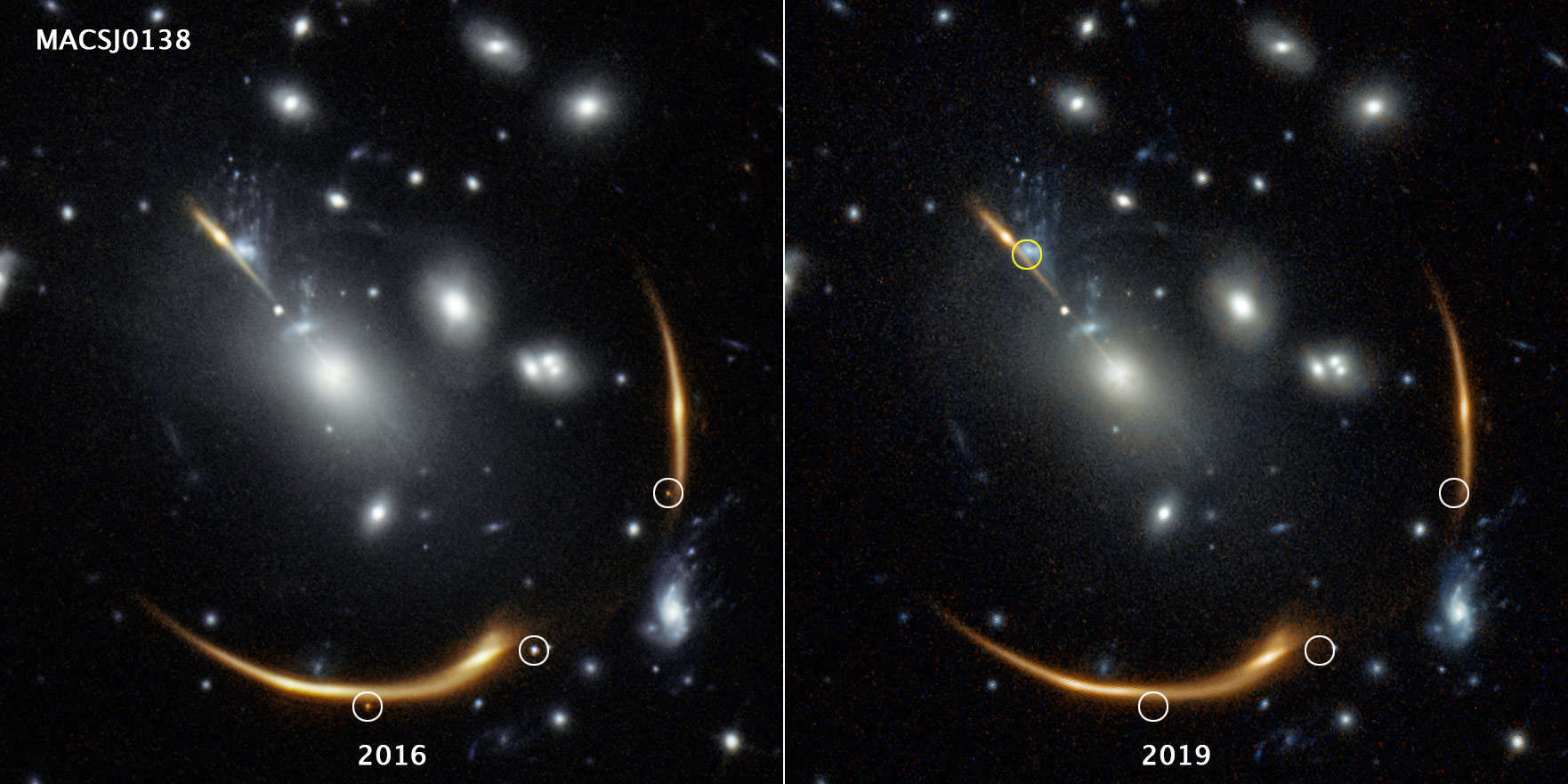Space warp puts a supernova on cosmic repeat

An intergalactic mirage of sorts is acting like a time machine for astronomers, allowing them to see a supernova at three different stages in the explosion simultaneously. And it’s going to allow them to see it again in a kind of cosmic rerun.
About 4 billion light years from Earth lies the magnificent galaxy cluster MACSJ0138.0-2155 (let’s call it MACS J0138 for short). This is a collection of hundreds of galaxies all bound together by their mutual gravity. The mass of the cluster is so strong it measurably warps space around it. Light coming from a more distant object behind it (relative to us) passes through this warped space and follows those curves like a car does on a curved road.
This has lots of weird and wonderful effects, including magnifying that light and even creating multiple images of the object. This is similar to how a lens works, so we call this gravitational lensing.
At this point let me say that I have written not only about lensing but about this specific cluster not long ago, and to save a few hundred words let me strongly urge you to pause for a moment and go read that article; it has all the background you need to understand what I’m about to tell you next.
OK, you good? Good. Moving on.
In the MACSJ0138 Hubble image is a background galaxy called MRG-M0138. It’s about 10 billion light year from us, so a very long way indeed. The lensing effect has created a bunch of separate images of it, smeared out into three arcs. One is at the bottom of the Hubble image, one on the right, and the third to the upper left, pointing toward the center. The bottom arc is actually two images of the galaxy overlapping, so they look like a single arc.
Here’s the fun bit. Images of the cluster taken in July 2016 show a dot in the galaxy, an extremely bright event that can be spotted in the bottom two lensed images and the one on the right as well.
Astronomers noticed this, and determined that the dot is most likely a supernova, an exploding star. They can outshine entire galaxies! A typical supernova takes about two weeks to reach that peak brightness, then fades for the next few months or years.
Here’s the thing: When something like a cluster makes multiple images of a galaxy behind it, it’s changing the path the light took to get to Earth. Those paths are generally different lengths, which means it takes the light in each image a different amount of time to get here. If the path length is longer, we’re seeing the supernova as it was earlier in time than the image that took a shorter path.
That’s what’s happening here. Careful measurements show the supernova is a different brightness in each lensed image, and that’s because we’re seeing the supernova at different stages in its evolution!
Modeling the way mass is distributed in the cluster allows astronomers to estimate the amount of delay between the different lensed images of the background galaxy and supernova. They also have a pretty good idea of how a supernova brightens and fades over time. Using that info plus the estimated delays, they were able to fit the measured brightness to what we’d expect from the supernova at a given time. If we call the brightness of the supernova at its peak Time 0, then the three images of it we see (starting at the bottom and moving counterclockwise) have times of 92, -24, and 107 days.
That’s amazing. We can actually see the supernova 24 days before it peaked! That’s unusual, and very helpful in being able to identify its behavior.
And it gets better. That upper smeared image, the one pointing toward the center of the cluster? They find it has a much longer delay, which is why you don’t see the supernova in it… yet. They predict that, due to the much longer path, the supernova should start to appear in it in the year 2037 (± 2 years). Hopefully we’ll have some ‘scopes pointed that way in 16 years to take a look. That’s a very long time baseline, and will really help nail down the estimates of the lenses and the mass distribution of the cluster.
By the way, the astronomers think this is a Type I supernova, the detonation of a white dwarf that’s been feeding off a companion star. That’s convenient, because these can be calibrated to measure distances. In fact they’ve been used for years to better understand how the Universe is expanding because they can be seen so far away and their distances can be fairly reliably measured. The astronomers who examined this supernova think that lensed supernovae like this can be used for this sort of thing, but it’ll take roughly 100 different lensed supernovae to work. That’s a lot, but with big survey telescopes coming online soon this sort of thing may be much easier and even commonplace.
The Universe is such a weird place, but that weirdness presents opportunities. That supernova would have been difficult to see on its own, but the lensing artificially brightened it for us. It also gives us four separate chances to observe it at different times in its life, and also to learn about the galaxy cluster warping our view. We win no matter what we study.
That’s true of astronomy in general, but it’s cool when the Universe conspires to make it easier.




























